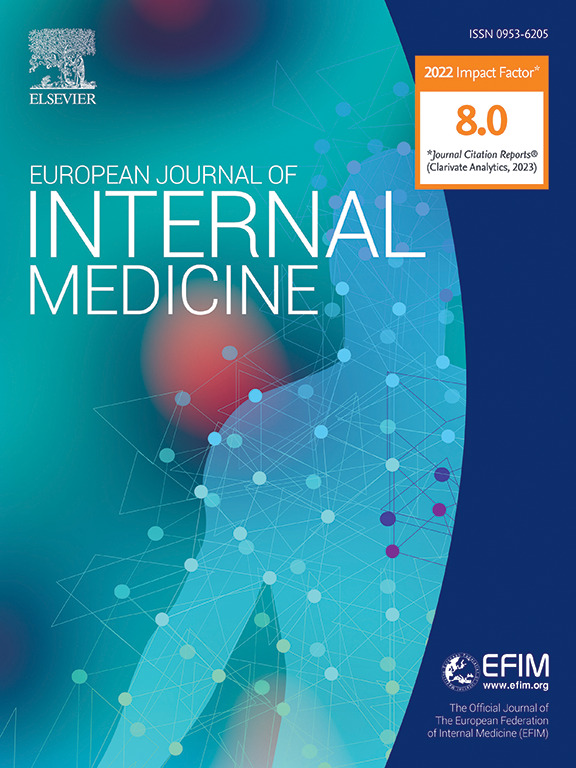脑血管疾病和认知功能障碍与中枢收缩压的关系。
IF 5.9
2区 医学
Q1 MEDICINE, GENERAL & INTERNAL
引用次数: 0
摘要
背景:高血压(BP)与脑小血管疾病(CSVD)和认知不良密切相关。然而,关于心血管疾病和认知功能障碍与中枢性血压的关系知之甚少。方法:1447名参与者(59.3%为女性;在社区动脉粥样硬化风险(ARIC)研究中,我们研究了mri定义的CSVD的相关性,其特征是对数转换白质高强度体积(log-WMHv),以及腔隙性梗死、大叶和皮质下微出血的存在,以及由迷你精神状态检查评分(中央收缩压(cSBP)每增加1个sd)确定的认知功能。用受试者工作特征曲线下面积(AUC)评价模型的性能。结果:校正潜在混杂因素后,cSBP与log-WMHv相关(β, 0.031;p = 0.003)和肺叶(OR, 1.58;p < 0.001)和皮质下微出血(OR, 1.20;P = 0.011)。在基础模型中加入cSBP可提高大叶微出血风险的模型性能(p = 0.042),而加入外周收缩压后AUC无统计学意义(p = 0.49)。不考虑调整因素,黑人与白人相比,cSBP与CSVD标志物和认知功能障碍的关联要强得多。在基础模型中加入cSBP后,黑人皮质下微出血的AUC从0.63提高到0.68 (p = 0.042)。结论:cSBP与CSVD和认知障碍相关。我们的观察结果强调,cSBP可能有助于进一步研究CSVD的预防策略。本文章由计算机程序翻译,如有差异,请以英文原文为准。
Cerebral small vessel disease and cognitive dysfunction in relation to central systolic blood pressure
Background
Higher blood pressure (BP) is closely associated with cerebral small vessel disease (CSVD) and poor cognition. However, little is known about the association of CSVD and cognitive dysfunction with central BP.
Methods
In 1447 participants (59.3 % women; mean age, 76.0 years) enrolled in the Atherosclerosis Risk in Communities (ARIC) study, we investigated the associations of MRI-defined CSVD, characterized by log-transformed white matter hyperintensity volumes (log-WMHv), and the presence of lacunar infarct, lobar and subcortical microhemorrhages, and cognitive function determined by the Mini Mental State Examination score with per 1-SD increment in central systolic BP (cSBP) derived by applanation tonometry. The model performance was assessed by the area under the receiver operating characteristic curve (AUC).
Results
After adjusted for potential confounders, cSBP was associated with log-WMHv (β, 0.031; p = 0.003) and lobar (OR, 1.58; p < 0.001) and subcortical microhemorrhages (OR, 1.20; p = 0.011). Adding cSBP to the base model enhanced the model performance for the risk of lobar microhemorrhages (p = 0.042), while AUC did not statistically increase with the addition of peripheral SBP (p = 0.49). Irrespective of adjustments, the associations of cSBP with CSVD markers and cognitive dysfunction were much stronger for Blacks compared with Whites. Incorporating cSBP into the base model significantly improved AUC from 0.63 to 0.68 (p = 0.042) for subcortical microhemorrhages in Blacks.
Conclusion
cSBP was associated with CSVD and cognition impairment. Our observations highlight that cSBP may help further investigation for the prevention strategies of CSVD.
求助全文
通过发布文献求助,成功后即可免费获取论文全文。
去求助
来源期刊
CiteScore
9.60
自引率
6.20%
发文量
364
审稿时长
20 days
期刊介绍:
The European Journal of Internal Medicine serves as the official journal of the European Federation of Internal Medicine and is the primary scientific reference for European academic and non-academic internists. It is dedicated to advancing science and practice in internal medicine across Europe. The journal publishes original articles, editorials, reviews, internal medicine flashcards, and other relevant information in the field. Both translational medicine and clinical studies are emphasized. EJIM aspires to be a leading platform for excellent clinical studies, with a focus on enhancing the quality of healthcare in European hospitals.

 求助内容:
求助内容: 应助结果提醒方式:
应助结果提醒方式:


